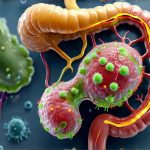The intricate ecosystem residing within our digestive tracts – collectively known as the gut microbiota – plays an undeniably crucial role in overall health. This complex community of trillions of microorganisms, including bacteria, fungi, viruses, and archaea, isn’t merely a passive bystander during digestion; it actively participates in vital processes such as nutrient absorption, immune system regulation, and even mental wellbeing. Maintaining the delicate balance within this microbial world is paramount for optimal function, yet modern life presents numerous challenges to its stability. One increasingly recognized threat comes from exposure to antibiotic residues present in our food supply, a consequence of their widespread use in animal agriculture.
Antibiotics are indispensable tools in veterinary medicine, employed not only to treat sick animals but also – controversially – as growth promoters and prophylactic measures against disease in large-scale farming operations. While intended to enhance animal health and productivity, this extensive antibiotic usage inevitably leads to residue accumulation within the edible tissues of livestock and poultry. These residues, even at low concentrations, can then be ingested by humans through consumption of meat, dairy products, and eggs, potentially disrupting the carefully orchestrated harmony of our gut microbiota. Understanding how these residues impact our internal ecosystem is essential for navigating the complexities of modern food systems and safeguarding human health. You may also want to explore hormonal balance as it relates to gut health.
The Pathway from Farm to Gut: Antibiotic Residue Exposure
The journey of antibiotic residues from agricultural settings to our plates is multi-faceted. Antibiotics administered to livestock are not fully metabolized by the animals; a portion is excreted, contaminating soil and water sources. Further residue remains within animal tissues – muscle, fat, and organs – at varying levels depending on the drug used, dosage, withdrawal periods (the time required before slaughter for residues to fall below safe limits), and species of animal. Even with adherence to regulated withdrawal times, trace amounts can still be present in food products. This isn’t necessarily indicative of non-compliance, but rather a consequence of how these drugs are absorbed and distributed within the animal’s body.
The primary routes of human exposure therefore include: – Direct consumption of contaminated meat, poultry, and dairy products. – Indirect exposure through drinking water sourced from areas impacted by agricultural runoff containing antibiotic residues. – Consumption of crops irrigated with or grown in soil exposed to these residues. The levels detected are often low, but chronic low-dose exposure is precisely what raises concerns about their impact on the human gut microbiota. It’s important to note that residue levels vary significantly based on farming practices and geographic location; organic farming generally utilizes far fewer antibiotics, minimizing this risk. Learning gut testing can help you understand your own gut health.
The challenge lies in detecting these residues accurately and comprehensively. While regulatory bodies establish maximum residue limits (MRLs) for various antibiotics in food products, testing isn’t always exhaustive or widespread enough to capture the full extent of contamination. Furthermore, many analytical methods struggle to detect multiple antibiotic classes simultaneously, meaning some residues might go undetected. This creates a complex scenario where assessing true exposure levels is difficult and requires ongoing research and monitoring.
Disrupting Microbial Communities: Mechanisms of Action
Antibiotic residues, even in small quantities, can exert selective pressure on the gut microbiota, mimicking the effects of antibiotic treatment in humans. This means they aren’t killing off all bacteria indiscriminately; instead, they target specific microbial populations, leading to an imbalance known as dysbiosis. The mechanisms through which this occurs are multifaceted and include: – Direct inhibition or killing of susceptible bacterial species. Antibiotics, even at sub-inhibitory concentrations, can interfere with bacterial growth and metabolism. – Alteration of the gut environment. Residues can change pH levels or nutrient availability, favouring the proliferation of resistant bacteria. – Disruption of quorum sensing. This is a communication system used by bacteria to coordinate behaviour; antibiotic residues can interfere with this process, affecting microbial community structure.
The consequences of dysbiosis are far-reaching. A healthy gut microbiota boasts diversity and resilience – it’s able to withstand perturbations and quickly recover its balance. However, when exposed to antibiotics (from food or other sources), sensitive bacteria are suppressed, leaving space for resistant strains to dominate. This can lead to a reduction in microbial diversity, loss of beneficial species (like Bifidobacteria and Lactobacilli crucial for immune function), and an overgrowth of potentially harmful organisms. This shift in composition weakens the gut’s ability to perform its vital functions, making it more vulnerable to infection and disease. You might find building gut resilience helpful for long term health.
Crucially, antibiotic residues don’t just affect bacteria; they can also impact fungi and other microbial components of the gut ecosystem. The interconnectedness of these communities means that disruption to one group can have cascading effects on others, further destabilizing the overall balance. The long-term consequences of this chronic exposure are still being investigated, but emerging research suggests links between early-life antibiotic residue exposure (through infant formula or maternal diet) and increased risk of allergies, autoimmune diseases, and metabolic disorders later in life.
Resistance and Selection Pressure: A Vicious Cycle
The overuse of antibiotics – both in human medicine and animal agriculture – is driving the global crisis of antimicrobial resistance (AMR). Exposure to antibiotic residues in food contributes directly to this problem by creating a selective environment that favours the proliferation of antibiotic-resistant bacteria. Bacteria are remarkably adaptable; they can develop mechanisms to neutralize or evade the effects of antibiotics through genetic mutations and horizontal gene transfer (sharing genes with other bacteria).
When an animal is exposed to antibiotics, even at low levels in their feed, resistant strains have a survival advantage. These resistant bacteria then colonize the animal’s gut and are shed into the environment. Humans consuming food from these animals ingest these resistant bacteria, potentially introducing them into their own gut microbiota. This can contribute to the spread of AMR genes, making infections harder to treat in both humans and animals. The cycle continues as more antibiotics are used, leading to further selection pressure and increased resistance levels.
The implications of rising AMR are profound. Infections that were once easily treated with common antibiotics are becoming increasingly difficult – or even impossible – to cure, leading to longer hospital stays, higher medical costs, and increased mortality rates. This isn’t just a public health concern; it’s an economic and social one as well. Addressing the problem requires a multi-pronged approach, including reducing antibiotic use in both human and animal medicine, improving hygiene practices, and developing new antimicrobial agents – but minimizing exposure through food is a critical piece of the puzzle.
Mitigating Exposure: What Can Be Done?
While completely eliminating antibiotic residues from our food supply is currently unrealistic, several strategies can help mitigate exposure and protect gut microbiota health. One key approach is supporting sustainable farming practices that prioritize animal welfare and reduce reliance on routine antibiotic use. Choosing organic meat, poultry, and dairy products – which are produced without the prophylactic use of antibiotics – is a proactive step consumers can take.
Beyond dietary choices, advocating for stronger regulations regarding antibiotic usage in agriculture is crucial. This includes stricter withdrawal periods, improved monitoring programs to detect residue levels accurately, and incentives for farmers to adopt alternative disease prevention strategies (such as vaccination or improved biosecurity measures). Furthermore, promoting research into novel farming techniques that minimize the need for antibiotics is essential.
On an individual level, bolstering gut health through dietary interventions can enhance resilience against antibiotic-induced dysbiosis. – Consuming a diverse diet rich in fibre and fermented foods (like yogurt, kefir, sauerkraut) provides nourishment for beneficial bacteria. – Reducing sugar intake and processed food consumption supports overall gut health. – Considering probiotic supplementation during or after periods of potential exposure to antibiotic residues might help restore microbial balance, but it’s important to consult with a healthcare professional before starting any new supplement regimen. Understanding gut acidity can also improve absorption.
Ultimately, addressing the issue of antibiotic residues in food requires a collaborative effort involving farmers, consumers, regulators, and researchers. By understanding the pathways of exposure, mechanisms of action, and consequences for gut health, we can make informed choices that protect our microbial ecosystems and safeguard public health for generations to come. It’s also important to balance enjoyment with digestive caution when making food choices. Finally, considering how a sensitive gut impacts relationships can be helpful – handle the gut.


















